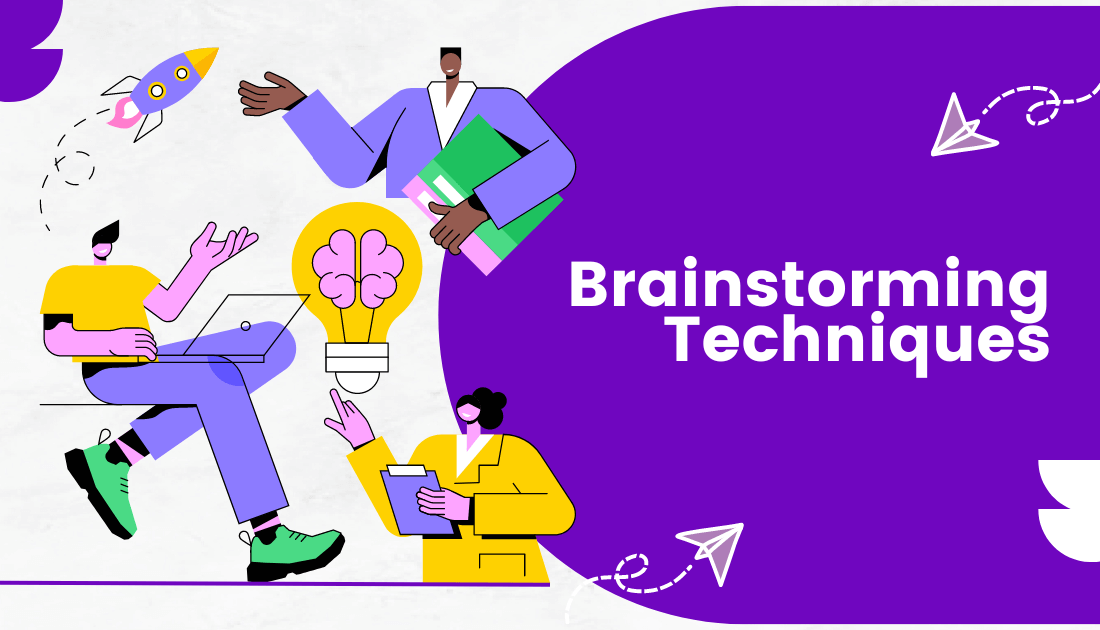Are you struggling to come up with innovative ideas or solutions? Look no further! In this article, we will explore various brainstorming techniques that can help you unlock your creativity and generate fresh perspectives. By utilizing these techniques, you can break free from the constraints of traditional thinking and tap into the limitless potential of your mind.
So get ready to unleash your imagination as we embark on a journey through various types of brainstorming that will revolutionize the way you think and generate ideas!
Brainstorming: Unleashing Creativity and Problem-Solving Potential
Brainstorming is a powerful technique used by individuals or teams to tackle problems, spur innovation, and generate fresh ideas for enhancing products, organizations, or strategies. Brainstorming can unlock creativity and solve complex challenges by following a structured process.
What is Brainstorming, You Ask?
Brainstorming is a collaborative approach that encourages participants to think freely, share ideas, and build upon each other’s contributions. It fosters an environment where no idea is deemed too outrageous or impractical, promoting a diverse range of perspectives and possibilities.
Three Steps of A Successful Brainstorming Session
Regardless of the chosen method, most brainstorming strategies involve three essential steps:
- Capture ideas: During this phase, participants generate and record as many ideas as possible without judgment or evaluation. The goal is to encourage a free flow of thoughts and maximize the number of suggestions.
- Discuss and critique the ideas: Once a substantial list of ideas has been generated, participants engage in a constructive discussion to examine and evaluate each suggestion. This step allows for clarification, expansion, and refinement of ideas through open communication.
- Choose which ideas to execute: Following the discussion and critique phase, participants collectively determine which ideas have the most potential for implementation. Selection criteria may include feasibility, impact, alignment with objectives, and resource availability.
The Ingredients for Effective Brainstorming
Every successful brainstorming session requires three fundamental elements:
- Individuals or groups: Brainstorming can be performed individually or in a group setting. Individual brainstorming allows for personal reflection and ideation, while group brainstorming harnesses the collective intelligence and diverse perspectives of multiple participants.
- A problem or opportunity: Brainstorming is initiated with a specific problem or opportunity in mind. It could range from addressing a technical issue in a product to finding innovative marketing strategies for a new business venture. Clearly defining the focus ensures a targeted and productive brainstorming session.
- Time: Sufficient time should be allocated to allow participants to engage in thorough idea generation, discussion, and evaluation. Rushing through the process may hinder creativity and limit the quality of the outcomes.
Common Challenges in Brainstorming Sessions and How to Overcome Them
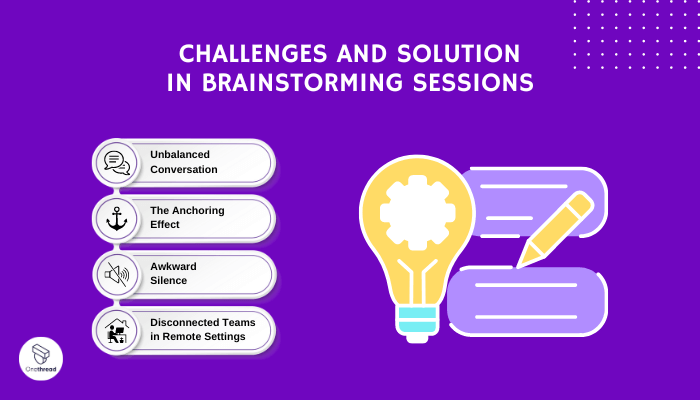
Brainstorming sessions are meant to be a collaborative and dynamic process for generating ideas and solving problems. However, several factors can hinder the effectiveness of a brainstorm, preventing teams from maximizing their creative potential.
Here we explore some common challenges that can derail brainstorming sessions and offers strategies to overcome them.
Unbalanced Conversation
One prevalent issue in brainstorming sessions is when extroverted individuals or quick thinkers dominate the conversation, leaving little room for other team members to contribute. This lack of balance can stifle creativity and hinder the exploration of diverse perspectives.
The Anchoring Effect
The anchoring effect occurs when participants fixate on the initial ideas presented during a brainstorming session. This fixation can limit the generation of new ideas and prevent the team from exploring alternative possibilities.
Overcoming the anchoring effect is crucial for fostering a more expansive and innovative brainstorming environment.
Awkward Silence
A lack of preparation among participants can lead to awkward silence during brainstorming sessions, creating an unproductive atmosphere. Alternatively, the session may be cut short to alleviate the discomfort. These situations hinder the free flow of ideas and impede the overall progress of the session.
Disconnected Teams in Remote Settings
With the rise of remote work during the pandemic, brainstorming sessions have shifted to video conferencing platforms. However, this transition brings its own challenges, such as the difficulty of capturing the creative energy that arises from having everyone physically present in the same room.
Additionally, remote sessions can be prone to interruptions and communication issues, further hindering the brainstorming process.
14 Effective Brainstorming Techniques – Different Types of Brainstorming Explained
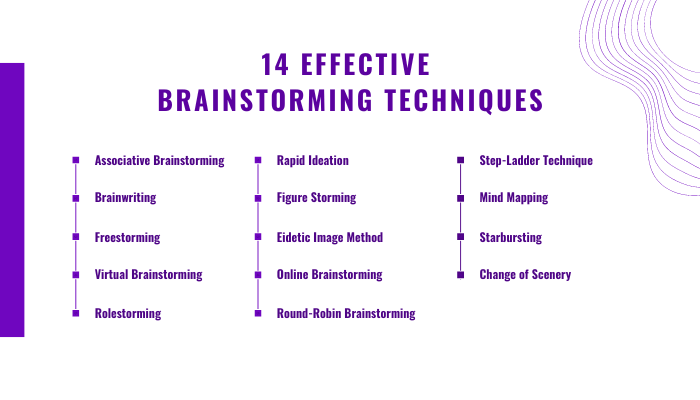
Associative Brainstorming
Associative brainstorming is a versatile technique that can be performed individually or in a group. By starting with a single word that captures the essence of an idea, participants jot down associated words that come to mind.
This process is most effective when the mind is allowed to roam freely, generating as many words as possible. The interplay of related words stimulates the brain to make new connections, fostering the emergence of fresh ideas.
The duration of the exercise can be tailored to suit preferences, ranging from 10 minutes to an hour.
Brainwriting: Unleashing Collective Creativity
Brainwriting is a collaborative brainstorming exercise that harnesses the collective creative potential of a team. The exercise begins with a team leader presenting a topic. Each team member writes down three ideas on a piece of paper, which is then passed to another member.
The process continues, with each subsequent participant building upon the ideas presented before them. Once completed, the team gathers to review and refine the generated ideas, discarding some and identifying others that inspire further exploration.
With additional brainstorming, average ideas can be transformed into extraordinary ones.
Freestorming: Capturing the Power of Uninhibited Thinking
Freestorming involves capturing every thought that comes to mind when contemplating an idea. In a quiet setting, individuals immerse themselves in free storming, noting down every relevant and irrelevant, good and bad idea in a notebook or on a computer.
This powerful technique allows for the uninhibited expression of “real and raw” ideas and encourages deep exploration, unveiling hidden possibilities waiting to be discovered.
Virtual Brainstorming: Overcoming Time and Space Barriers
Virtual brainstorming, also known as online brainstorming, has become increasingly popular as teams are often geographically dispersed. With a reliable internet connection, teams can gather on a centralized online platform to initiate and facilitate discussions.
Collaboration tools, such as OneThread, offer a seamless communication and collaboration experience, enabling teams to conduct brainstorming sessions through discussions and capture important insights in the notes section.
Virtual brainstorming eliminates the constraints of time and space, allowing for efficient idea generation.
Rolestorming: Embracing Empathy and Creativity
Rolestorming injects an element of fun and engagement into the brainstorming process. Instead of thinking from their own perspective, participants imagine themselves in someone else’s shoes, such as their boss, mentor, or even prominent figures like Warren Buffett, Steve Jobs, or Barack Obama.
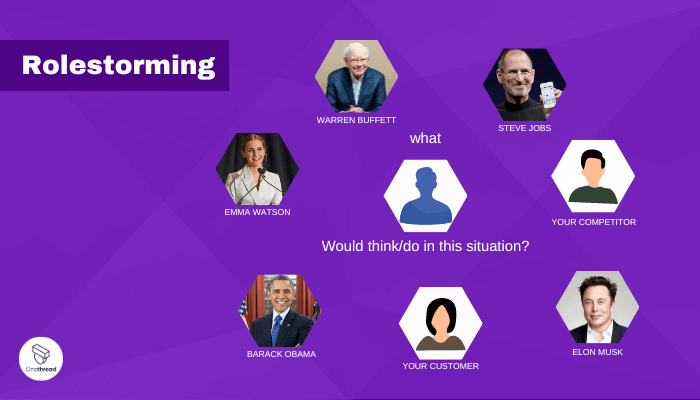
This technique encourages participants to break free from their own limitations and inhibitions, fostering fresh ideas while retaining their authenticity. By adopting the mindset of influential individuals, rolestorming allows for unique insights and a glimpse into the world of the great thinkers.
Rapid Ideation
In this technique, everyone writes down as many ideas as possible within a set time before any ideas are discussed. This prevents premature dismissal of ideas and encourages the sharing of raw thoughts.
Figure Storming
This involves discussing how a well-known figure not present in the room would approach the problem. This can help the team approach the problem from a different perspective and encourages more creative sharing.
Eidetic Image Method
This visualization-based method involves using vivid mental images to build upon an existing design or idea. It’s particularly useful when the goal is to enhance an existing concept rather than reinvent it.
Online Brainstorming (Brain Netting)
This technique involves using a central location, such as a shared document or a chat platform, for team members to write down their ideas. It’s especially useful for remote teams and can help level the playing field.
Round-Robin Brainstorming
In this method, every member contributes one idea in turn. This ensures everyone gets to participate and all ideas are shared before moving on to the critique phase.
Step-Ladder Technique
This complex technique involves introducing team members one by one to the brainstorming session, allowing each person to share their ideas before learning about the ideas already discussed. This helps avoid undue influence from the first few ideas or the loudest voices.
Mind Mapping
Starting with one idea, the group draws lines connecting sub-ideas to the first one. This visual approach can be helpful for those who think visually.
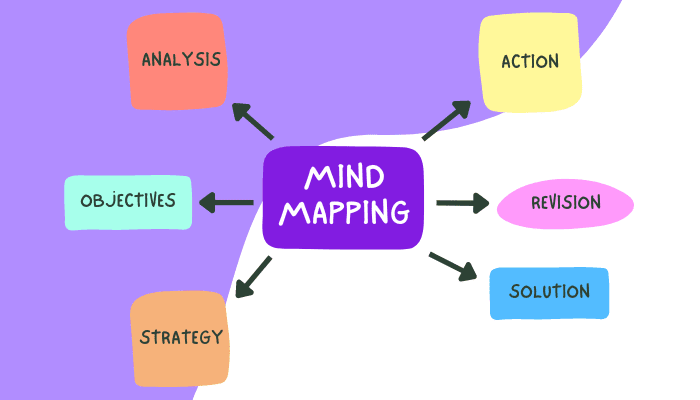
Starbursting
This later-stage technique involves creating a six-point star around an idea, with each point representing a question: who, what, when, where, why, and how. This helps the team examine an idea from every angle.
Change of Scenery
Moving the brainstorming session to a different location can help stimulate new ideas. A new environment can help people think differently and come up with fresh ideas.
Benefits of Team Brainstorming: Enhancing Collaboration and Creativity
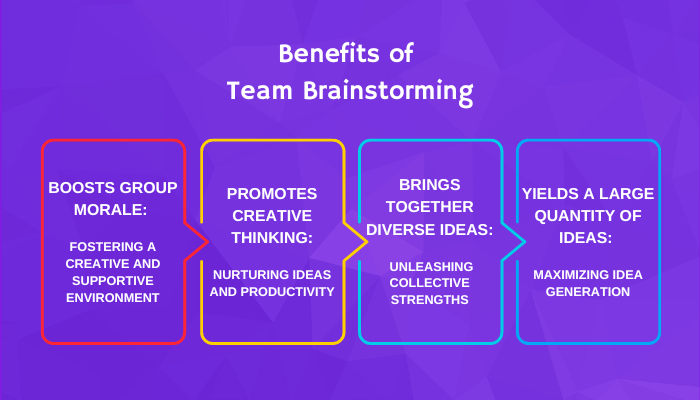
Boosts Group Morale: Fostering a Creative and Supportive Environment
Brainstorming as a team boosts group morale by creating a sense of unity and shared purpose. Collaborating in a creative and supportive setting allows teammates to engage face-to-face, strengthening team bonds.
To reap this benefit, it is crucial to withhold criticisms during the initial idea-capturing phase of the brainstorming process.
Promotes Creative Thinking: Nurturing Ideas and Productivity
Amidst the hustle and bustle of daily tasks, individuals often lack dedicated time for free-flowing idea generation, even in creative fields. Allocating specific time for unrestricted idea exploration without distractions is essential for maintaining creativity.
Furthermore, rallying individuals around a common topic or idea reduces isolation and can significantly enhance productivity. Unlike traditional meetings where preparedness is expected, brainstorms provide a space for half-baked ideas to be shared, serving as catalysts for new insights and building upon each other’s contributions.
Brings Together Diverse Ideas: Unleashing Collective Strengths
The collective brainstorming process surpasses the individual capabilities of team members. By bringing together diverse perspectives and strengths, group brainstorming generates more robust outcomes than solo ideation.
The variety of viewpoints sparks innovation and enables comprehensive problem-solving.
Yields a Large Quantity of Ideas: Maximizing Idea Generation
One of the key advantages of team brainstorming lies in the sheer quantity of ideas produced. While not every idea will be a winner, the abundance of generated ideas ensures a higher likelihood of discovering valuable concepts.
Following a brainstorming session, it is important to conduct a planning session to identify the most promising ideas and develop strategies for implementation.
These team brainstorming benefits can be further enhanced by employing structured brainstorming techniques. To boost creative energy, consider exploring creative quotes that can invigorate you and your team throughout the process.
Final Word
By incorporating these diverse brainstorming methods into your creative process, you can enhance your problem-solving skills and come up with innovative solutions. Whether you are working on a business project or pursuing personal goals, these methods will help unlock your imagination and generate fresh ideas.
So next time you find yourself in need of inspiration or facing a creative block, remember the power of these brainstorming techniques – they might just lead you to brilliant breakthroughs!
